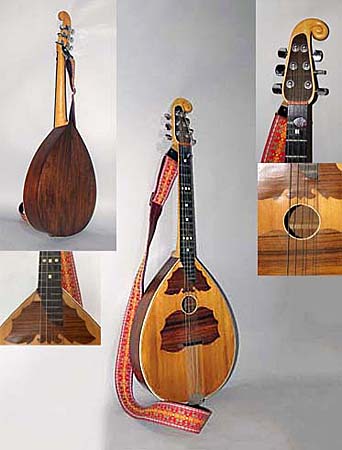
Owner: HWMC
Catalog#: 2CL-CHLT-059
Miscellaneous Lutes
Croatian ‘Tamburica – Brac'
Croatia
Maker Unknown
Wood, pigment, mother-of-pearl, metal strings, metal
Mid-Late 20th century
Length: 35 in
Strings – Lutes – Miscellaneous Lutes
Tamburica or tamboura sometimes written tamburrizza or tamburitza, refers to a family of long-necked lutes popular in Southern Europe and Central Europe, especially Serbia, Bosnia and Herzegovina, Croatia, Slovenia, and Hungary (predominantly amongst its ethnic South Slavic minority groups). It is also known in Burgenland, Austria. Because of its longtime presence and development in Croatia, it is recognized as the national folk instrument of the Croatian people.
All of the tamburica instruments took their name and some characteristics from the Persian tanbur but also resembles the mandolin and guitar in the sense that its strings are plucked and often paired. The frets may be moveable to allow the playing of various modes. The variety of tamburica shapes known today were developed in Serbia and Croatia by several indigenous contributors near the end of the 19th century.
Large tamburica orchestras began to form with formal written compositions after the turn of the 20th century. These all-string ensembles consist of the following five sizes and functions: The oval shaped ‘Prim’ or ‘Bisernica,’ the smallest that played the melody and harmony; The tenor guitar shaped brac or basprim, the next in size, that played the melody and harmony in the mid-range octaves. Next was the guitar shaped celo, close to size of a folk guitar, that played the counter melody in the lower octave, much like a cello in a symphony. Then similar in size and shape to the celo was the bugarija or konta, that plays only chords for counter rhythm. Finally, is the double bass shaped bas or berta that plays the bass part of the rhythm in the lowest octave. There are several orchestras still today carrying on the traditions in the US, such as the Detroit Tamburitza Orchestra. Previously in their homeland, the groups consisted of five or six musicians playing simple folk songs and dances at weddings and other social events.
This is a brac or bas-prim tamburica that is often guitar-shaped, but this one is roundish like the bisernica. The top half of the resonator body has different wood. The neck ends in a flat tuning head with a sideways scroll, and metal encased tuning machines. There is also a metal plate on the front of the scroll. This brac has six metal strings with two strings doubled and is often an octave lower than the bisernica: E A dd gg.
References: https://en.wikipedia.org/wiki/Tamburica; http://www.detroittamburitzaorchestra.com/index.php/history-of-dto; March, Richard (2013-11-14). The Tamburitza Tradition: From the Balkans to the American Midwest. University of Wisconsin Pres. ISBN 9780299296032; http://www.atlasofpluckedinstruments.com/europe2.htm
